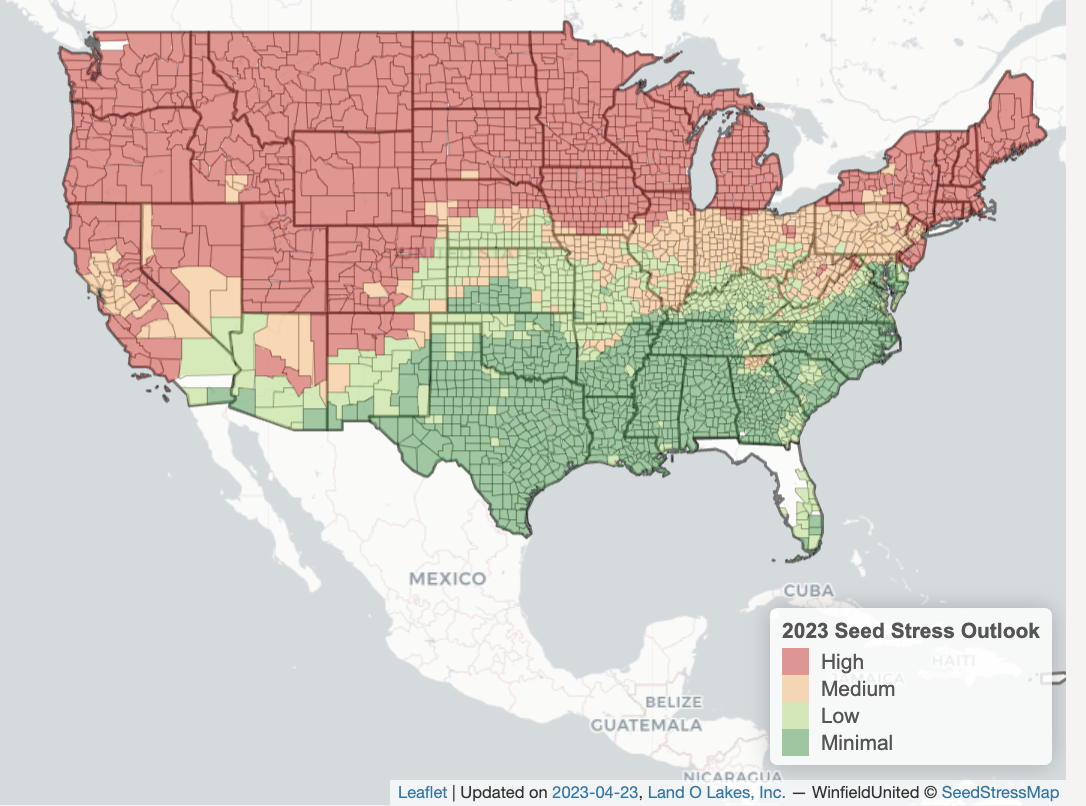As spring planting gets underway, wet and cold conditions threaten to negatively impact germination and therefore yield potential for many farmers across the country. While these conditions can change quickly as the season progresses, current soil moisture and temperature levels show a large swath of the country is currently under a “High/Medium Seed Stress” outlook according to the In-Season Seed Stress Map from WinField United, which monitors weekly planting conditions like soil temperature and soil moisture to provide a predicted stress level by county.
potential for many farmers across the country. While these conditions can change quickly as the season progresses, current soil moisture and temperature levels show a large swath of the country is currently under a “High/Medium Seed Stress” outlook according to the In-Season Seed Stress Map from WinField United, which monitors weekly planting conditions like soil temperature and soil moisture to provide a predicted stress level by county.
Joe Rickard, crop protection product manager with WinField United, has been closely monitoring conditions and has four tips for growers to better navigate cool, wet soils this spring.
1. Don’t get impatient — wait for the right planting conditions.
Focus on soil temperature and moisture levels to determine the best planting dates. Planting corn before temperatures reach 50 degrees and trending upwards can lead to imbibitional chilling, and planting soybeans too early could result in devastating frost damage. But this season, Rickard sees another issue looming based on moisture levels.
“We see the potential for sidewall compaction to be an issue this year with the wet conditions,” said Rickard. “Planting in mud can cause compaction, smear the sidewall of the seed trench and even cause the seed to rot and die so it’s important to closely monitor your moisture levels.”
2. Consider a boost to in-furrow applications.
“Starter fertilizers applied at planting can help stimulate root development and increase nutrient availability to small plants,” said Rickard. “Zinc and phosphorus, which tend to be more limited when soils are wet and cool, are in many starter fertilizers and are vital to early plant growth.”
In addition to starter fertilizer, Rickard recommends adding a plant growth regulator like Ascend2® to corn to speed up the germination process and promote more vigorous and even emergence in spring and significantly boost yield potential come fall.
3. Safeguard vulnerable seeds against diseases and insects.
“With many growers looking to plant soybeans earlier in search of more yield, we continue to see an increase in disease pressure from Pythium, Rhizoctonia, Fusarium and Phytophthora when planting into cold, wet conditions,” said Rickard. “A quality seed treatment such as Warden® CX II can help mitigate these early-season seed stresses in soybeans and maximize yield potential.”
In corn, wet conditions have made Pythium a prevalent disease challenge the last few planting seasons. Rickard recommends Fortivent® Plus seed treatment, which provides control of Pythium as well as insects and aids in early-season plant growth and root development with the inclusion of zinc.
4. Stabilize your nitrogen to avoid loss from high moisture rates.
Wet conditions can also pose challenges to maximizing nitrogen applications.
“Applying a nitrogen (N) stabilizer along with your N products will be important to help get every possible pound of your N investment into the plant,” said Rickard. “Nitrogen stabilizers limit microbial activity in the soil reducing the conversion of ammonium into nitrate, which keeps nitrogen in a form that is less susceptible to loss by leaching or denitrification.”
To learn more about navigating challenging early-season planting conditions, talk to your local WinField United affiliated retailer, or visit winfieldunited.com.

